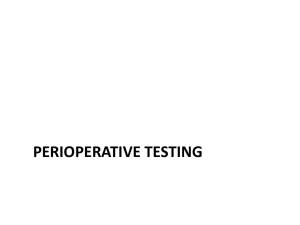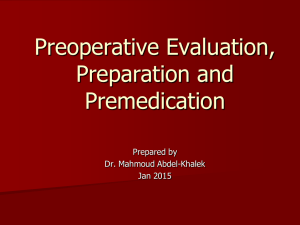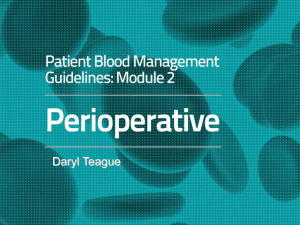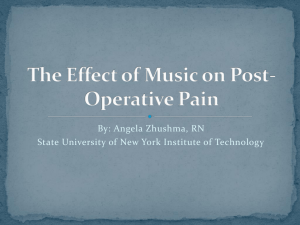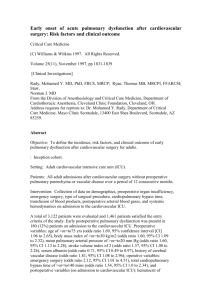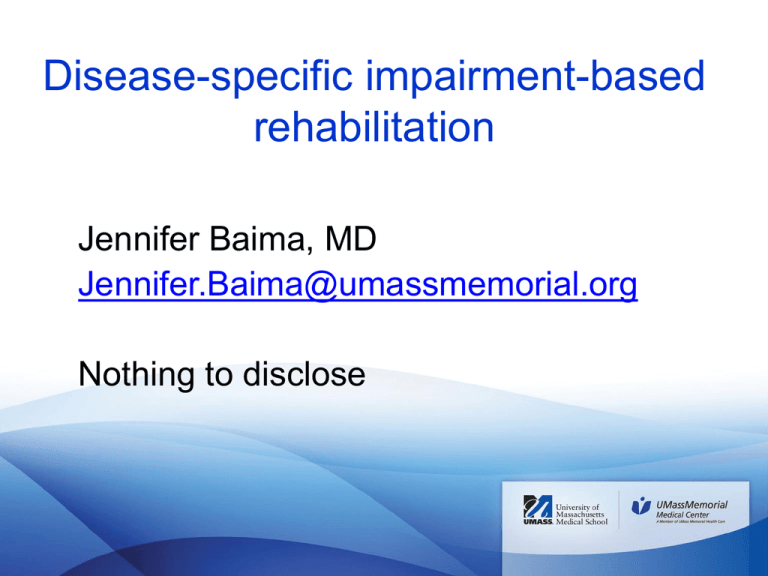
Disease-specific impairment-based
rehabilitation
Jennifer Baima, MD
Jennifer.Baima@umassmemorial.org
Nothing to disclose
• Colorectal
– nutrition
– delaying surgery worsens outcomes (absent prehab)
• Lung
– pulmonary function
– delaying surgery may not worsen outcomes (non-small
cell)
• Prostate
– urinary/ sexual function
– May not need individualized program
• Breast
– shoulder pain, weakness, and limited range of motion
• Head and neck
– swallowing dysfunction
Measuring
Improvement
Timeline
colorectal
prostate
lung
head and neck
Gastrointestinal prehabilitation
Reversing nutritional deficiencies
and improving compliance
West, M. A., et al. "Effect of prehabilitation on objectively measured physical
fitness after neoadjuvant treatment in preoperative rectal cancer patients: a
blinded interventional pilot study."
• 6 weeks of 3x weekly sessions on an exercise
bike returns (cardiopulmonary) fitness to
baseline levels after chemo
surgery
chemotherapy
radiation
Cho, Haruhiko, et al. "Matched Pair Analysis to Examine the
Effects of a Planned Preoperative Exercise Program in Early
Gastric Cancer Patients with Metabolic Syndrome to Reduce
Operative Risk: The Adjuvant Exercise for General Elective
Surgery (AEGES) Study Group."
• Matched pair analysis of 4 week
preoperative exercise (aerobic, resistance,
stretching) with no serious adverse events
• Decreased volume of visceral fat
• Postoperative complications in 5.5% vs
40.7%
Gillis, Chelsia, et al. "Prehabilitation versus
Rehabilitation: A Randomized Control Trial in Patients
Undergoing Colorectal Resection for Cancer."
• Trimodal intervention
– dietician, kinesiologist, and psychologist on
home-based interventions
• RCT with two groups:
– Prehab (38 patients) = 4 weeks before and for
8 weeks post-op
– Rehab (39 patients) = 8 weeks post-op only
• Preop: improvement in 6 MWT by average
of 25.2 m vs decline of 16.4 m in rehab
group
• 4 weeks post: both groups < 20 m below
baseline
• 8 weeks post: prehab group above
baseline and rehab group below baseline
25.2 m increase preop offsets
21.8 m decline postop for a net gain
Gastrointestinal impairments
• Abdominal weakness
• Chest
weakness/atelectasis
• Fatigue
Lung prehabilitation
improving pumonary function
and changing treatment options
High prevalence of COPD (left)
Total oxygen intake of muscles during low
level exercise
Other
Respiratory
Other
Respiratory
Morano MT et al. Preoperative pulmonary rehabilitation versus
chest physical therapy in patients undergoing lung cancer
resection: a pilot randomized controlled trial.
• Prehab pilot vs incentive spirometry without IMT
• Warm up and cool down
• 1. Upper limb- 15 reps per minute of diagonal
movements
• 2. Lower limb- treadmill walking- 10min 1st
week, 20 min 2nd week, 30min 3rd week, 30 min
4th week
• 3. Inspiratory muscle training- inhaling through
the mouth against pressure
Rodriguez-Larrad, Ana, et al. "Perioperative physiotherapy in
patients undergoing lung cancer resection."
• 8 studies of 599 patients: two preoperative,
four postoperative, and two that started
preoperatively and continued
• Prognosis is related to preoperative
performance on exercise testing
• Presurgical time period is most crucial
in changing exercise performance
Timeline and heterogeneity
• 5 sessions per week for 4 weeks of aerobic
exercise
• 14 sessions per week for one week of aerobic
exercise
• 14-21 sessions per week of physical therapy for
one week before surgery and until discharge
• 35 sessions per week of independent noninvasive pressure support ventilation for one week
before surgery to three days after
Lung impairments
• Cardiopulmonary
dysfunction
• Respiratory muscle
weakness/
atelectasis
• Fatigue
Prostate prehabilitation
Preventing pelvic floor dysfunction
and overcoming changing
hormones
Presentation Title
17
Bernardo-Filho, Mario, et al. "The Relevance of the Procedures
Related to the Physiotherapy in the Interventions in Patients with
Prostate Cancer: Short Review with Practice Approach."
• Physiotherapy is
effective before and
after treatment
• Urinary incontinence
– Internal sphincter
deficiency
– Bladder dysfunction
• Erectile dysfunction
April 13, 2015
Presentation Title
18
• Unique functions of pelvic
floor muscles
• Biofeedback,
electrotherapy, external
vacuum devices
• 29%-97.5% rate of ED
after radical prostatectomy
• Psychotherapy; sex
therapy; oral, intraurethral,
or intracavernosal
pharmacologic agents;
and surgery
April 13, 2015
Presentation Title
19
• Decrease of
postoperative
complications in
patients who have
undergone prehab
• Improvement not
observed until
exercises are done
after surgery
• Taught and practiced
for at least 3 weeks for
UI and 3 months for ED
April 13, 2015
Presentation Title
20
Bruun, D. M., et al. "“All boys and men can play football”: A
qualitative investigation of recreational football in prostate
cancer patients."
• 50% undergo androgen
deprivation
• Unlike male colorectal and
lung cancer patients, do not
change behavior at
diagnosis
• 12 weeks of supervised
football increases exercise
compliance
• Access to professionals
and accountability
April 13, 2015
Presentation Title
21
Genitourinary impairments
• Urinary dysfunction
• Sexual dysfunction
• Fatigue
Breast prehabilitation
Preventing shoulder problems and
lymphedema
Sagen, Aase, et al. "Upper Limb Physical Function and
Adverse Effects After Breast Cancer Surgery: A
Prospective 2.5-Year Follow-Up Study and
Preoperative Measures."
Type of surgery
ALND
SLNB
arm lymphedema
17%
(only affected side)
shoulder abduction- increase 6%
provoked pain
3%
Grip strength
reduction
2%
12%
decrease
50%
Martins Da Silva RC, Rezende LF. Asessment of impact of late
postoperative physical functional disabilities on quality of life in
breast cancer survivors. Tumori 2014 Jan-Feb: 100(1): 87-90
• 4-5 years after ALND
• Limited ipsilateral
shoulder flexion,
external rotation, and
abduction range of
motion
• Negative impact on
functional capacity and
global quality of life
• 28% had lymphedema
NIH Clinical Center Program
Springer BA et al. Preoperative assessment enables early diagnosis and recovery
of shoulder function in patients with breast cancer. Breast Cancer Research and
Treatment
26
Breast prehab study
• Prehabilitation intervention: 3 exercises
– Codman’s exercise
– Scapular squeezes
– Reach for the pillow
- 3 sets of 10 daily in the one to four weeks prior
to surgery
• Eval pain and range of motion before
surgery, 1 month postoperative, and 3
months postoperative
Courneya, K. S., et al. "Subgroup effects in a randomised trial of
different types and doses of exercise during breast cancer
chemotherapy." British journal of cancer (2014).
• Metabolic vs “cancer” variables
• Dose response: Elevated BMI moderates
the effect of exercise during chemotherapy
in breast cancer, but self-reported exercise
baseline does not
– 25-30 minutes of aerobic
– 50-60 minutes of aerobic
– 50-60 minutes of aerobic and resistance
Cerulli, Claudia, et al. "Therapeutic Horseback Riding in Breast
Cancer Survivors: A Pilot Study." The Journal of Alternative and
Complementary Medicine 20.8 (2014): 623-629.
-10 of 20 women > 6
months after breast
cancer treatment
-VO2 max, strength
including shoulder
press, and FACIT-F
after 16 weeks of
equine-assisted
therapy
Breast Cancer Impairments
• Range of motion of
shoulder
• Bone/ joint pain from
aromatase inhib.
• Chemo-induced
neuropathy
• Lymphedema
• Sexuality
30
Head and neck cancer
Preventing swallowing and
speech dysfunction
Cavalot AL et al. The importance of preoperative swallowing therapy
in subtotal laryngectomies. Otolaryngology–Head and Neck Surgery (2009) 140, 822-825
• 47 subtotal laryngectomy
patients
• The average time to
swallowing resumption
was 27.76 days for the 25
patients who received ST
only after surgery, and
16.38 for the 22 patients
who underwent ST both
before and after surgery.
Impairments in HNC
Impairment
Prevalence (%)
Ingestion
75
Articulation
67
Taste
66
Voice
61
Pain
59
Structure of head and neck
82%
Prehabilitation clinical trials and clinical care
Compliance
– Accountability
– Access to health care professionals
– Able to do it


